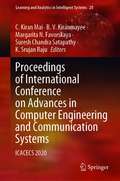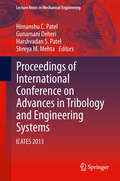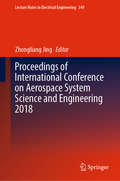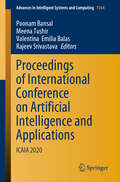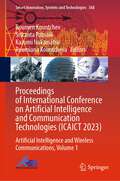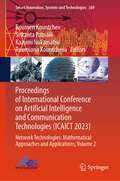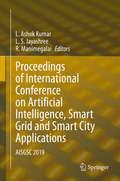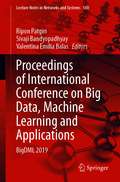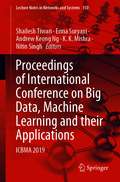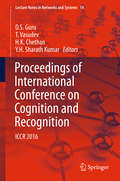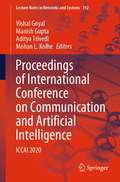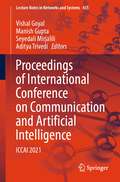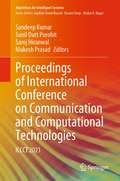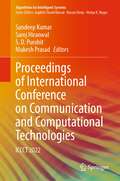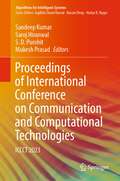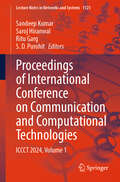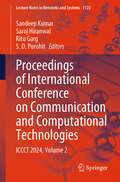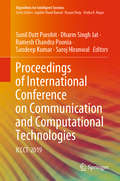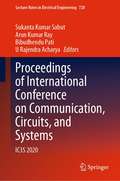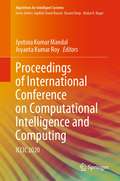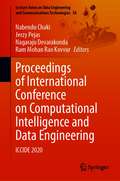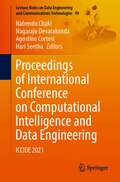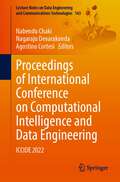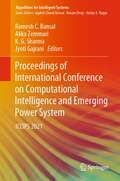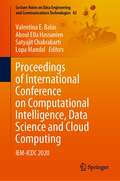- Table View
- List View
Proceedings of International Conference on Advances in Computer Engineering and Communication Systems: ICACECS 2020 (Learning and Analytics in Intelligent Systems #20)
by Margarita N. Favorskaya Suresh Chandra Satapathy K. Srujan Raju C. Kiran Mai B. V. KiranmayeeThis book comprises the best deliberations with the theme “Smart Innovations in Mezzanine Technologies, Data Analytics, Networks and Communication Systems” in the “International Conference on Advances in Computer Engineering and Communication Systems (ICACECS 2020)”, organized by the Department of Computer Science and Engineering, VNR Vignana Jyothi Institute of Engineering and Technology. The book provides insights on the recent trends and developments in the field of computer science with a special focus on the mezzanine technologies and creates an arena for collaborative innovation. The book focuses on advanced topics in artificial intelligence, machine learning, data mining and big data computing, cloud computing, Internet on things, distributed computing and smart systems.
Proceedings of International Conference on Advances in Tribology and Engineering Systems
by Himanshu C. Patel Gunamani Deheri Harshvadan S. Patel Shreya M. MehtaThis book contains advanced-level research material in the area of lubrication theory and related aspects, presented by eminent researchers during the International Conference on Advances in Tribology and Engineering Systems (ICATES 2013) held at Gujarat Technological University, Ahmedabad, India during October 15-17, 2013. The material in this book represents the advanced field of tribology and reflects the work of many eminent researchers from both India and abroad. The treatment of the presentations is the result of the contributions of several professionals working in the industry and academia. This book will be useful for students, researchers, academicians, and professionals working in the area of tribology, in general, and bearing performance characteristics, in particular, especially from the point-of-view of design. This book will also appeal to researchers and professionals working in fluid-film lubrication and other practical applications of tribology. A wide range of topics has been included despite space and time constraints. Basic concepts and fundamentals techniques have been emphasized upon, while also including highly specialized topics and methods (such as nanotribology, bio-nanotribology). Care has been taken to generate interest for a wide range of readers, considering the interdisciplinary nature of the subject.
Proceedings of International Conference on Aerospace System Science and Engineering 2018 (Lecture Notes in Electrical Engineering #549)
by Zhongliang JingThis book presents high-quality contributions in the subject area of Aerospace System Science and Engineering, including topics such as: Trans-space vehicle systems design and integration, Air vehicle systems, Space vehicle systems, Near-space vehicle systems, Opto-electronic system, Aerospace robotics and unmanned system, Aerospace robotics and unmanned system, Communication, navigation and surveillance, Dynamics and control, Intelligent sensing and Information fusion, Aerodynamics and aircraft design, Aerospace propulsion, Avionics system, Air traffic management, Earth observation, Deep space exploration, Bionic micro-aircraft/spacecraft.The book is a selection of articles from the 2nd International Conference on Aerospace System Science and Engineering, held in Moscow, Russia, from 31 July to 1 August 2018. The conference is co-organized by Shanghai Jiao Tong University and Moscow Aviation Institute. This is a forum that brings together experts in astronautics and aeronautics to share new ideas and findings.
Proceedings of International Conference on Artificial Intelligence and Applications: ICAIA 2020 (Advances in Intelligent Systems and Computing #1164)
by Valentina Emilia Balas Poonam Bansal Meena Tushir Rajeev SrivastavaThis book gathers high-quality papers presented at the International Conference on Artificial Intelligence and Applications (ICAIA 2020), held at Maharaja Surajmal Institute of Technology, New Delhi, India, on 6–7 February 2020. The book covers areas such as artificial neural networks, fuzzy systems, computational optimization technologies and machine learning.
Proceedings of International Conference on Artificial Intelligence and Communication Technologies: Artificial Intelligence and Wireless Communications, Volume 1 (Smart Innovation, Systems and Technologies #368)
by Srikanta Patnaik Kazumi Nakamatsu Roumen Kountchev Roumiana KountchevaThis book gathers selected papers presented at the International Conference on Artificial Intelligence and Communication Technologies (ICAICT2023), held at Shenzhen, China during June 2023. The first volume of the proceedings will focus on the newest methods and algorithms in smart wireless communications in the areas of Remote sensing and machine learning, Intelligent image and data processing, Health systems and security, Intelligent teaching applications and many others.
Proceedings of International Conference on Artificial Intelligence and Communication Technologies: Network Technologies: Mathematical Approaches and Applications, Volume 2 (Smart Innovation, Systems and Technologies #369)
by Srikanta Patnaik Kazumi Nakamatsu Roumen Kountchev Roumiana KountchevaThis book contains selected papers presented at the International Conference on Artificial Intelligence and Communication Technologies (ICAICT'23), held at Shenzhen, China in June 2023. This second volume of the proceedings is focused on new methods, algorithms and mathematical approaches, developed on the basis of Deep Learning and Artificial Intelligence, with various applications in information security, efficient power management, multimedia, and many others.
Proceedings of International Conference on Artificial Intelligence, Smart Grid and Smart City Applications: AISGSC 2019
by L. Ashok Kumar L. S. Jayashree R. ManimegalaiDue to the complexity, and heterogeneity of the smart grid and the high volume of information to be processed, artificial intelligence techniques and computational intelligence appear to be some of the enabling technologies for its future development and success. The theme of the book is “Making pathway for the grid of future” with the emphasis on trends in Smart Grid, renewable interconnection issues, planning-operation-control and reliability of grid, real time monitoring and protection, market, distributed generation and power distribution issues, power electronics applications, computer-IT and signal processing applications, power apparatus, power engineering education and industry-institute collaboration. The primary objective of the book is to review the current state of the art of the most relevant artificial intelligence techniques applied to the different issues that arise in the smart grid development.
Proceedings of International Conference on Big Data, Machine Learning and Applications: BigDML 2019 (Lecture Notes in Networks and Systems #180)
by Valentina Emilia Balas Sivaji Bandyopadhyay Ripon PatgiriThis book covers selected high-quality research papers presented at the International Conference on Big Data, Machine Learning, and Applications (BigDML 2019). It focuses on both theory and applications in the broad areas of big data and machine learning. It brings together the academia, researchers, developers and practitioners from scientific organizations and industry to share and disseminate recent research findings.
Proceedings of International Conference on Big Data, Machine Learning and their Applications: ICBMA 2019 (Lecture Notes in Networks and Systems #150)
by Shailesh Tiwari K. K. Mishra Nitin Singh Erma Suryani Andrew Keong NgThis book contains high-quality peer-reviewed papers of the International Conference on Big Data, Machine Learning and their Applications (ICBMA 2019) held at Motilal Nehru National Institute of Technology Allahabad, Prayagraj, India, during 29–31 May 2020. The book provides significant contributions in a structured way so that prospective readers can understand how these techniques are used in finding solutions to complex engineering problems. The book covers the areas of big data, machine learning, bio-inspired algorithms, artificial intelligence and their applications.
Proceedings of International Conference on Cognition and Recognition
by D. S. Guru T. Vasudev H. K. Chethan Y.H. Sharath KumarThe book covers a comprehensive overview of the theory, methods, applications and tools of cognition and recognition. The book is a collection of best selected papers presented in the International Conference on Cognition and Recognition 2016 (ICCR 2016) and helpful for scientists and researchers in the field of image processing, pattern recognition and computer vision for advance studies. Nowadays, researchers are working in interdisciplinary areas and the proceedings of ICCR 2016 plays a major role to accumulate those significant works at one place. The chapters included in the proceedings inculcates both theoretical as well as practical aspects of different areas like nature inspired algorithms, fuzzy systems, data mining, signal processing, image processing, text processing, wireless sensor networks, network security and cellular automata.
Proceedings of International Conference on Communication and Artificial Intelligence: ICCAI 2020 (Lecture Notes in Networks and Systems #192)
by Mohan L. Kolhe Aditya Trivedi Vishal Goyal Manish GuptaThis book is a collection of best selected research papers presented at the International Conference on Communication and Artificial Intelligence (ICCAI 2020), held in the Department of Electronics & Communication Engineering, GLA University, Mathura, India, during 17–18 September 2020. The primary focus of the book is on the research information related to artificial intelligence, networks, and smart systems applied in the areas of industries, government sectors, and educational institutions worldwide. Diverse themes with a central idea of sustainable networking solutions are discussed in the book. The book presents innovative work by leading academics, researchers, and experts from industry.
Proceedings of International Conference on Communication and Artificial Intelligence: ICCAI 2021 (Lecture Notes in Networks and Systems #435)
by Seyedali Mirjalili Aditya Trivedi Vishal Goyal Manish GuptaThis book is a collection of best selected research papers presented at the International Conference on Communication and Artificial Intelligence (ICCAI 2021), held in the Department of Electronics & Communication Engineering, GLA University, Mathura, India, during 19–20 November 2021. The primary focus of the book is on the research information related to artificial intelligence, networks, and smart systems applied in the areas of industries, government sectors, and educational institutions worldwide. Diverse themes with a central idea of sustainable networking solutions are discussed in the book. The book presents innovative work by leading academics, researchers, and experts from industry.
Proceedings of International Conference on Communication and Computational Technologies: ICCCT 2021 (Algorithms for Intelligent Systems)
by Sandeep Kumar Sunil Dutt Purohit Saroj Hiranwal Mukesh PrasadThis book gathers selected papers presented at 3rd International Conference on Communication and Computational Technologies (ICCCT 2021), jointly organized in virtual format by Rajasthan Institute of Engineering and Technology, Jaipur and Rajasthan Technical University Kota in association with Soft Computing Research Society, during 27–28 February 2021. The volume is a collection of state-of-the-art research work in the cutting-edge technologies related to communication and intelligent systems. The topics covered are algorithms and applications of intelligent systems, informatics and applications, and communication and control systems.
Proceedings of International Conference on Communication and Computational Technologies: ICCCT 2022 (Algorithms for Intelligent Systems)
by Sandeep Kumar Saroj Hiranwal S. D. Purohit Mukesh PrasadThis book gathers selected papers presented at 4th International Conference on Communication and Computational Technologies (ICCCT 2022), jointly organized by Soft Computing Research Society (SCRS) and Rajasthan Institute of Engineering & Technology (RIET), Jaipur, during February 26–27 2022. The book is a collection of state-of-the art research work in the cutting-edge technologies related to the communication and intelligent systems. The topics covered are algorithms and applications of intelligent systems, informatics and applications, and communication and control systems.
Proceedings of International Conference on Communication and Computational Technologies: ICCCT 2023 (Algorithms for Intelligent Systems)
by Sandeep Kumar Saroj Hiranwal S. D. Purohit Mukesh PrasadThis book gathers selected papers presented at 5th International Conference on Communication and Computational Technologies (ICCCT 2023), jointly organized by Soft Computing Research Society (SCRS) and Rajasthan Institute of Engineering & Technology (RIET), Jaipur, during January 28–29, 2023. The book is a collection of state-of-the art research work in the cutting-edge technologies related to the communication and intelligent systems. The topics covered are algorithms and applications of intelligent systems, informatics and applications, and communication and control systems.
Proceedings of International Conference on Communication and Computational Technologies: ICCCT 2024, Volume 1 (Lecture Notes in Networks and Systems #1121)
by Sandeep Kumar Saroj Hiranwal S. D. Purohit Ritu GargThis book gathers selected papers presented at 6th International Conference on Communication and Computational Technologies (ICCCT 2024), jointly organized by Soft Computing Research Society (SCRS) and Rajasthan Institute of Engineering & Technology (RIET), Jaipur, during January 8–9, 2024. The book is a collection of state-of-the art research work in the cutting-edge technologies related to the communication and intelligent systems. The topics covered are algorithms and applications of intelligent systems, informatics and applications, and communication and control systems.
Proceedings of International Conference on Communication and Computational Technologies: ICCCT 2024, Volume 2 (Lecture Notes in Networks and Systems #1122)
by Sandeep Kumar Saroj Hiranwal S. D. Purohit Ritu GargThis book gathers selected papers presented at 6th International Conference on Communication and Computational Technologies (ICCCT 2024), jointly organized by Soft Computing Research Society (SCRS) and Rajasthan Institute of Engineering & Technology (RIET), Jaipur, during January 8–9, 2024. The book is a collection of state-of-the art research work in the cutting-edge technologies related to the communication and intelligent systems. The topics covered are algorithms and applications of intelligent systems, informatics and applications, and communication and control systems.
Proceedings of International Conference on Communication and Computational Technologies: ICCCT-2019 (Algorithms for Intelligent Systems)
by Sandeep Kumar Dharm Singh Jat Sunil Dutt Purohit Ramesh Chandra Poonia Saroj HiranwalThis book offers a collection of high-quality peer-reviewed research papers presented at the Second International Conference on Communication and Computational Technologies (ICCCT 2019), held at Rajasthan Institute of Engineering and Technology, Jaipur, Rajasthan, India, on 30–31 August 2019. In contributions prepared by researchers from academia and industry alike, the book discusses a wide variety of industrial, engineering and scientific applications of emerging techniques.
Proceedings of International Conference on Communication, Circuits, and Systems: IC3S 2020 (Lecture Notes in Electrical Engineering #728)
by Bibudhendu Pati Sukanta Kumar Sabut Arun Kumar Ray U Rajendra AcharyaThe book proposes new technologies and discusses innovative solutions to various problems in the field of communication, circuits, and systems, as reflected in high-quality papers presented at International Conference on Communication, Circuits, and Systems (IC3S 2020) held at KIIT, Bhubaneswar, India from 16 – 18 October 2020. It brings together new works from academicians, scientists, industry professionals, scholars, and students together to exchange research outcomes and open up new horizons in the areas of signal processing, communications, and devices.
Proceedings of International Conference on Computational Intelligence and Computing: ICCIC 2020 (Algorithms for Intelligent Systems)
by Jyotsna Kumar Mandal Joyanta Kumar RoyThis book includes the original, peer-reviewed research articles from the International Conference on Computational Intelligence and Computing (ICCIC 2020), held in September 2020 on a virtual platform jointly organized by SR Group of Institutions, Jhansi, India, IETE, Kolkata Centre, India, and Eureka Scientech Research Foundation, Kolkata India. It covers the latest research in image processing, computer vision and pattern recognition, machine learning, data mining, big data and analytics, information security and privacy, wireless and sensor networks and IoT applications, artificial intelligence, expert systems, natural language processing, image processing, computer vision, artificial neural networks, fuzzy logic, evolutionary optimization, rough sets, web intelligence, intelligent agent technology, virtual reality, and visualization.
Proceedings of International Conference on Computational Intelligence and Data Engineering: ICCIDE 2020 (Lecture Notes on Data Engineering and Communications Technologies #56)
by Nabendu Chaki Nagaraju Devarakonda Jerzy Pejas Ram Mohan Rao KovvurThis book is a collection of high-quality research work on cutting-edge technologies and the most-happening areas of computational intelligence and data engineering. It includes selected papers from the International Conference on Computational Intelligence and Data Engineering (ICCIDE 2020). It covers various topics, including collective intelligence, intelligent transportation systems, fuzzy systems, Bayesian network, ant colony optimization, data privacy and security, data mining, data warehousing, big data analytics, cloud computing, natural language processing, swarm intelligence and speech processing.
Proceedings of International Conference on Computational Intelligence and Data Engineering: ICCIDE 2021 (Lecture Notes on Data Engineering and Communications Technologies #99)
by Nabendu Chaki Agostino Cortesi Nagaraju Devarakonda Hari SeethaThis book covers various topics, including collective intelligence, intelligent transportation systems, fuzzy systems, Bayesian network, ant colony optimization, data privacy and security, data mining, data warehousing, big data analytics, cloud computing, natural language processing, swarm intelligence, and speech processing. This book is a collection of high-quality research work on cutting-edge technologies and the most-happening areas of computational intelligence and data engineering. It includes selected papers from the International Conference on Computational Intelligence and Data Engineering (ICCIDE 2021).
Proceedings of International Conference on Computational Intelligence and Data Engineering: ICCIDE 2022 (Lecture Notes on Data Engineering and Communications Technologies #163)
by Nabendu Chaki Agostino Cortesi Nagaraju DevarakondaThis book is a collection of high-quality research work on cutting-edge technologies and the most-happening areas of computational intelligence and data engineering. It includes selected papers from the International Conference on Computational Intelligence and Data Engineering (ICCIDE 2022). It covers various topics, including collective intelligence, intelligent transportation systems, fuzzy systems, Bayesian network, ant colony optimization, data privacy and security, data mining, data warehousing, big data analytics, cloud computing, natural language processing, swarm intelligence and speech processing.
Proceedings of International Conference on Computational Intelligence and Emerging Power System: ICCIPS 2021 (Algorithms for Intelligent Systems)
by Akka Zemmari Ramesh C. Bansal K. G. Sharma Jyoti GajraniThis book gathers outstanding research papers presented in the International Conference on Computational Intelligence and Emerging Power System (ICCIPS 2021), held on March 9-10, 2021, at Engineering College Ajmer. ICCIPS 2021 is jointly organized by the Department of CSE and Department of EE, Engineering College Ajmer, Rajasthan, India. The topics covered in the book are collective intelligence, soft computing, optimization, cloud computing, machine learning, intelligent software, robotics, data science, data security, big data analytics, natural language processing, renewable energy, signal processing, optimization methods for power system, smart grid, micro-grid, energy management, power system, monitoring system, load management, and distributed generation.
Proceedings of International Conference on Computational Intelligence, Data Science and Cloud Computing: IEM-ICDC 2020 (Lecture Notes on Data Engineering and Communications Technologies #62)
by Aboul Ella Hassanien Satyajit Chakrabarti Valentina E. Balas Lopa MandalThis book includes selected papers presented at International Conference on Computational Intelligence, Data Science and Cloud Computing (IEM-ICDC) 2020, organized by the Department of Information Technology, Institute of Engineering & Management, Kolkata, India, during 25–27 September 2020. It presents substantial new research findings about AI and robotics, image processing and NLP, cloud computing and big data analytics as well as in cyber security, blockchain and IoT, and various allied fields. The book serves as a reference resource for researchers and practitioners in academia and industry.
